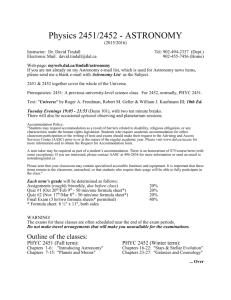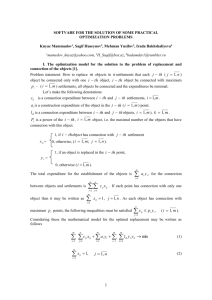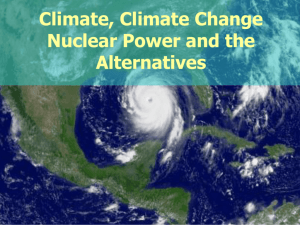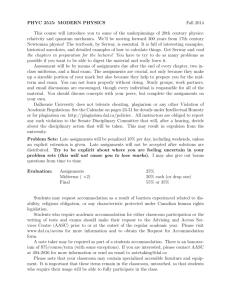PHYC 40050 Environmental Physics
advertisement
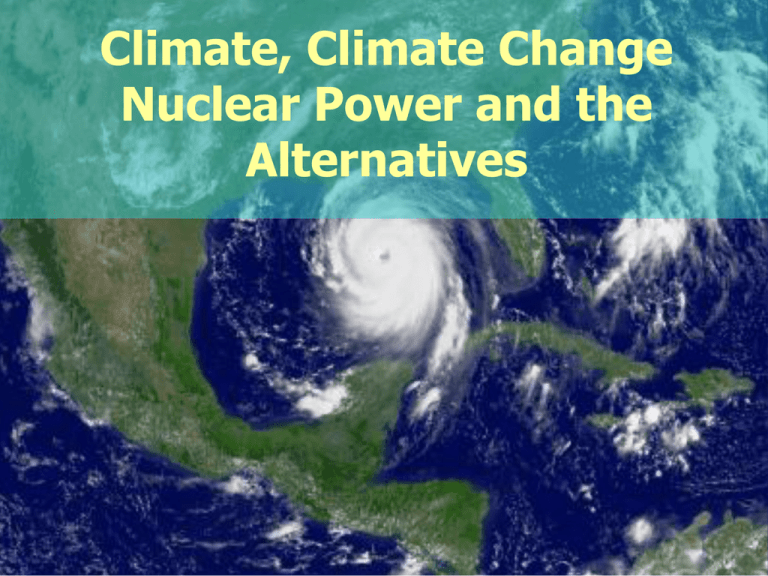
Climate, Climate Change Nuclear Power and the Alternatives PHYC 40050 Environmental Physics Climate, Climate Change Nuclear Power and the Alternatives PHYC 40050 Peter Lynch Meteorology & Climate Centre School of Mathematical Sciences University College Dublin PHYC 40050 Environmental Physics Lecture 5 Modelling Climate Change PHYC 40050 Environmental Physics Feature: February 2007 “A model approach to climate change” Adam Scaife, Chris Folland and John Mitchell “The Earth is warming up, with potentially disastrous consequences.” PHYC 40050 Environmental Physics IPCC http://www.ipcc.ch The Intergovernmental Panel on Climate Change Fourth Assessment Report Climate Change 2007 PHYC 40050 Environmental Physics Climate Change 2007: The Physical Science Basis Summary for Policymakers Warming of the climate system is unequivocal … ... there is very high confidence that the effect of human activities has been one of warming. PHYC 40050 Environmental Physics Concentration of CO2 Mauna Loa, Hawaii, 1958–2004 PHYC 40050 Environmental Physics Climate Change 2007: The Physical Science Basis Summary for Policymakers The atmospheric concentration of carbon dioxide in 2005 exceeds by far the natural range over the last 650,000 years. PHYC 40050 Environmental Physics CO2 Concentration, last 10,000 years x Human population, last 7,000 years PHYC 40050 Environmental Physics x PHYC 40050 Environmental Physics Climate Change 2007: The Physical Science Basis Summary for Policymakers For the next two decades a warming of about 0.2°C per decade is projected ... It is very likely that hot extremes, heat waves, and heavy precipitation events will continue to become more frequent. PHYC 40050 Environmental Physics PHYC 40050 Environmental Physics Climate Change 2007: The Physical Science Basis Summary for Policymakers Anthropogenic warming and sea level rise will continue for centuries due to the timescales associated with climate processes and feedbacks. PHYC 40050 Environmental Physics How do they do that? How does the IPCC know what is going to happen? Our best means of anticipating climate change is by means of computer climate models. PHYC 40050 Environmental Physics A Physical Model: Spitfire The “real thing” Airfix Model PHYC 40050 Environmental Physics A Mathematical Model: The Population Explosion Observation Prediction Model PHYC 40050 Environmental Physics Climate Models • The climate system is enormously complex • Climate models are amongst the most complex models in all of science • Climate models are based on fluid mechanics and thermodynamics PHYC 40050 Environmental Physics The Basis of Climate Modelling Newton’s Law of Motion F = ma PHYC 40050 Environmental Physics PHYC 40050 Environmental Physics T h e r m o d y n a m i c s PHYC 40050 Environmental Physics The Atmospheric Equations • The Navier-Stokes Equations • The Continuity Equation • Continuity Equation for Water • The Thermodynamic Equation • The Equation of State (Boyle/Charles) PHYC 40050 Environmental Physics Source PHYC term40050 Environmental Physics Computational Grid PHYC 40050 Environmental Physics Vilhelm Bjerknes (1862–1951) PHYC 40050 Environmental Physics Bjerknes’ 1904 Manifesto To predict future states of the atmosphere. We need: 1. A sufficiently accurate knowledge of the initial state of the atmosphere 2. A sufficiently accurate knowledge of the laws of physics governing its behaviour. PHYC 40050 Environmental Physics Lewis Fry Richardson (1881–1953) Richardson computed by hand the pressure change at a single point. It took him two years ! His ‘forecast’ was a catastrophic failure: Δp = 145 hPa in 6 hours PHYC 40050 Environmental Physics Richardson’s Forecast Factory (…the start of The Big Crunch…) PHYC 40050 Environmental Physics ENIAC Electronic Numerical Integrator and Computer The first multipurpose programmable electronic digital computer • 18,000 valves • 70,000 resistors • 10,000 capacitors • 6,000 switches • 140 kWatts power PHYC 40050 Environmental Physics Line: Moore’s Law PHYC 40050 Environmental Physics Computer Forecasting Skill [The longest verification series in existence] PHYC 40050 Environmental Physics Elements of the Climate System • • • • • The atmosphere The ocean The cryosphere The geosphere The biosphere There are interactions between these sub-systems All these sub-systems are represented in modern Earth System Models PHYC 40050 Environmental Physics Parameterisation We have to represent a wide range of processes occurring on scales smaller than the resolution of the models. • • • • Convective and stratiform clouds Infrared and visible radiation The topography of the Earth's surface Atmospheric turbulence on many scales. PHYC 40050 Environmental Physics CLOUDS AND CLIMATE Low clouds reflect sunlight but trap little infra-red radiation; They act to cool climate High clouds reflect sulight but also trap infra-red radiation; They act to warm climate Global warming may change the characteristics of clouds, thus altering their effect on climate PHYC 40050 Environmental Physics UNCERTAINTIES IN CLIMATE CHANGE PREDICTIONS Projections of future emissions Initial climate conditions Natural and human climate factors Realism of the climate model feedbacks resolution extremes of climate Surprises ! ! ! PHYC 40050 Environmental Physics Some Irish Contributors to Meteorology & Climate Science • • • • • • • Robert Boyle (1627-1691) Richard Kirwan (1733–1812) Francis Beaufort (1774–1857) John Tyndall (1820–1893) George G Stokes (1819–1903) William Thompson (1824–1907) Osborne Reynolds (1842–1912) PHYC 40050 Environmental Physics John Tyndall (1820–1893) • Born at Leighlinbridge Co Carlow • Studied with Bunsen in Marburg • Associated with Royal Institution • Assistant to Michael Faraday • Wrote 16 books and 145 papers. PHYC 40050 Environmental Physics Tyndall and the Greenhouse Effect “without water vapour, the Earth’s surface would be held fast in the iron grip of frost” Tyndall showed that water vapour, CO2 and ozone are strong absorbers of heat radiation Tyndall speculated how changes in water vapour and CO2 are related to climate change This is what we call the Greenhouse Effect. PHYC 40050 Environmental Physics THE GREENHOUSE EFFECT Visible energy from the sun passes through the glass and heats the ground Infra-red heat energy from the ground is partly reflected by the glass, and some is trapped inside the greenhouse PHYC 40050 Environmental Physics PHYC 40050 Environmental Physics PHYC 40050 Environmental Physics Hurricane Katrina • • • • • • Sustained winds 175 mph Category 5 storm at maximum Category 4 on landfall 150 miles wide: as big as Ireland 10 metre storm surge Torrential rainfall. PHYC 40050 Environmental Physics Katrina and Global Warming Was Hurricane Katrina due to climate change? We cannot be sure. Storms like this have occurred before. However, violent hurricanes will become more common in a warmer world: Higher temperatures => Warmer oceans => More moisture and energy => Larger, fiercer storms. PHYC 40050 Environmental Physics Extraordinarily Mild Autumn, 2006 PHYC 40050 Environmental Physics Return time for Normal fit PHYC 40050 Environmental Physics European Heatwave, Summer 2003 • The hottest Summer in 500 years. • There were more than 27,000 excess deaths due to the heat. Was this merely a rare meteorological event or a first glimpse of things to come? Probably both! PHYC 40050 Environmental Physics Temperature Anomaly, June–August, 2003 Colour: Deviation from 1961–1990 mean. Contours: ΔT normalized by standard deviation. PHYC 40050 Environmental Physics Summer 2007 has been simulated with and without the effect of mankind’s activities [Schär, et al., Nature, 427, Jan 22, 2004] Conclusion: Such heatwaves are now four times more likely, due to human influence on climate. PHYC 40050 Environmental Physics Distribution of Temperatures Swiss temperature series, 1864–2003 The 2003 heatwave was far outside the expected range. It was an extremely rare event: σ = 0.94K ΔT = 5.4 σ PHYC 40050 Environmental Physics Predicted Change in Distribution Both mean and standard deviation will change. Top: Distribution in past: T = 16.1 ̊ C, σ = 0.97 ̊ C Bottom: Distribution in future: T = 20.7 ̊ C, σ = 1.84 ̊ C PHYC 40050 Environmental Physics Consequences of global warming Increased frequency of floods and droughts Water supplies and ecosystems under threat Agricultural practices will have to change Millions of people displaced as the sea rises Global economy severely affected. PHYC 40050 Environmental Physics Why trust climate models? • Based on established laws of physics • Embody our best knowledge about the interactions and feedback mechanisms • Forecast weather skilfully over days ahead • Reproduce the current worldwide climate • Simulate ice ages & Holocene warm period. PHYC 40050 Environmental Physics Surprises It is very likely that we will be unpleasantly surprised by factors unforeseen. Let us call such events Unanticipated Emergent Phenomena “UEPs” The term “Banana Skins” does not have sufficient academic gravitas. PHYC 40050 Environmental Physics A UEP: The Ozone Hole The Ozone Hole was not Anticipated Initial response was disbelief It was explained after the event ! PHYC 40050 Environmental Physics Nonlinear systems: bifurcations. Example: Hurricanes require SST > 26 ̊ C If SST were everywhere below 26 ̊ C, we would not know about hurricanes Atmospheric systems we have yet to dream of may be possible PHYC 40050 Environmental Physics Positive Feedbacks • Water vapour • Clouds (sign uncertain ! ) • Ice-albedo effect • Carbon cycle: Death of rainforests • CO2 and Methane from thawing permafrost • Methane hydrates from beneath ocean floor. PHYC 40050 Environmental Physics Climate out of control If a positive feedback is not controlled, it could trigger further run-away effects A qualitative change of climate regime cannot be ruled out. There is an unquantifiable risk of catastrophic climate change PHYC 40050 Environmental Physics We face a clear challenge • To avoid drastic changes by minimizing production of greenhouse gases • To develop responsible mitigation and adaptation policies • To avoid reaching a “tipping-point” where a UEP will get us. PHYC 40050 Environmental Physics End of Lecture 5 PHYC 40050 Environmental Physics


